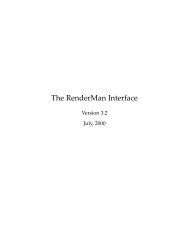Controlling Fluid Simulations with Custom Fields in Houdini Master ...
Controlling Fluid Simulations with Custom Fields in Houdini Master ...
Controlling Fluid Simulations with Custom Fields in Houdini Master ...
Create successful ePaper yourself
Turn your PDF publications into a flip-book with our unique Google optimized e-Paper software.
• as an axis aligned plane that shows a coloured slice <strong>in</strong> the volume, mapp<strong>in</strong>gthe values of the eld to the colours on the plane. (useful for temperature)With<strong>in</strong> SOPS a volume will generally be visualized as smoke when the values ofthe eld are positive. This means as well that when you are try<strong>in</strong>g to visualizea eld that has negative values, such as velocity or temperature, noth<strong>in</strong>g willbe shown <strong>in</strong> the viewport <strong>in</strong> SOPS, even though the data is actually there. Aquick check can be performed by tak<strong>in</strong>g the absolute value of the data <strong>in</strong>sidea volumevop just for visualization purposes to make sure the data exists. Atthis po<strong>in</strong>t visualiz<strong>in</strong>g your custom elds <strong>in</strong> dops will give you more options asdescribed above. The reason why this section on visualiz<strong>in</strong>g volumes <strong>in</strong> SOPS is<strong>in</strong>cluded is because it is not <strong>in</strong> DOPS, which means no solv<strong>in</strong>g needs to happento visualize the eld which makes it faster to shape volume elds <strong>in</strong>dependentof the previous frames. Also it is important to understand negative values arenot displayed <strong>in</strong> the viewport as this clarication will hopefully avoid confusionlater on when the tool is used and there seems to be no output.4.2.5 Houd<strong>in</strong>i specic tra<strong>in</strong><strong>in</strong>gSidefx, the creators of Houd<strong>in</strong>i, provide a great set of masterclass tutorials onuids and the pyrotools on their website which will help when learn<strong>in</strong>g how touse microsolvers and understand volume elds <strong>in</strong> Houd<strong>in</strong>i [15].4.3 The equations of uidsA signicant amount of research has already been done <strong>in</strong> the area of computationaluid dynamics (CFD) for simulat<strong>in</strong>g smoke, re or various types ofliquids. A few of the equations will be covered to help expla<strong>in</strong> the componentsthat make up a simple smoke solver <strong>in</strong> Houd<strong>in</strong>i.4.3.1 The <strong>in</strong>compressible Navier Stokes equationsThere is a consensus among scientists that the Navier Stokes equations are avery good model for uid ow [17]. That is why they tend to be used as afoundation for a lot of solvers, that will then <strong>in</strong> some way modify or extendthese equations:∂⃗u∂t + ⃗u · ∇⃗u + 1 ∇ρ = ⃗g + v∇ · ∇⃗u (1)ρWhere:⃗utρgvvelocitytimepressurebody forcesviscosity∇ · −→ u = 0 (2)11















